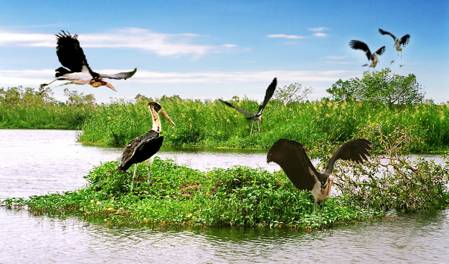VietnamSurprise – U Minh Ha national park (Lower U Minh National Park) is located in Ca Mau province. Which covered an area of 82.86 square kilometers.
>> U Minh Ha cajuput forest – The destination of South Vietnam
U Minh National Park in the southernmost province of Ca Mau is fast becoming an appealing eco-tourism area. It is considered the lungs of the Mekong Delta and is second only to the Amazon in South America in terms of biodiversity. The lower section of U Minh Ha National Park contains the Vo Doi protected forest, which boasts over 3,600 hectares of cajeput forest. The cajeput trees flower all year round and attract swarms of bees which produce an excellent quality honey. U Minh Ha also has 6,000 hectares of peat, one of the biggest peat reserves in Vietnam. The lush vegetation of U Minh Ha provides habitat for a diverse fauna, including 72 species of mammals and birds. Several of these species are listed in the International Union for the Conservation of Nature and Natural Resources’ (IUCN) Red List and Vietnam’s Red Book of endangered species, such as “Tê Tê” (Manis A crane stands on the bank of a canal in U Minh Ha pentadactyla), the hair-nosed otter (Lutra sumatrana) and the king cobra (Ophiophagus hannah).
Nestling in the green foliage and marshlands of U Minh Ha are various kinds of waterfowls like herons, egrets, storks, ibises, ducks, rails and shorebirds. A large variety of freshwater fish can also be found swimming in the brackish water, including “Cá rô” (Anabas testudineus), “Cá lóc” (Ophiocephalus maculatus), “Cá lóc” (Clariidae) and “Cá thác lác” (Notopterus notopterus Pallas). Many efforts are under-way to transform this natural sanctuary into an inviting eco-tourism destination, promising visitors a host of exciting activities. Visitors to U Minh National Park can go fishing and cook their catch, or they can be served local specialties such as “Cá Lóc nướng trui” (unscaled fish grilled whole in straws) and “Cá kèo nướng ống tre” (small fish grilled in bamboo chunks). In U Minh Ha National Park, there is also a 110 ha tourism complex where visitors can canoe along canals to see beehives, rest in hammocks, indulge in local delicacies complex where visitors can canoe and honey.
Source: vnppa.org.vn

